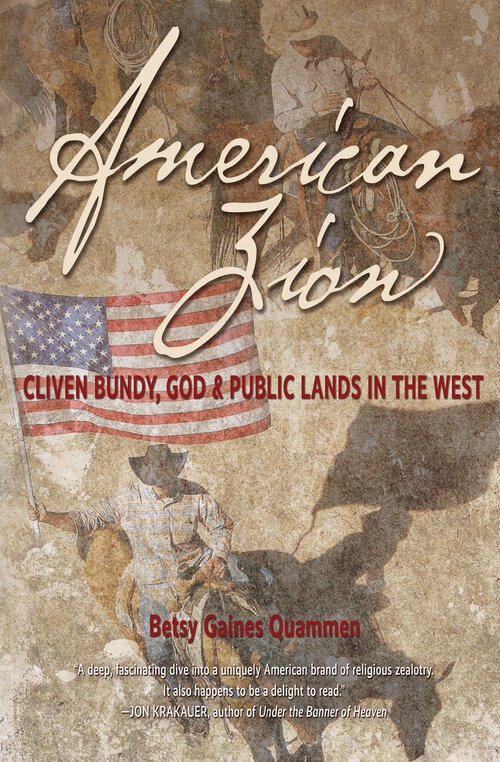A Cowboy Named Mary
American Zion is coming out in March and I can’t tell you how damn excited I am. I worked hard on the thing and I’m happy to share it with the world. There have been so many who have inspired me in the process. Recently, names of people have come to mind whom I forgot to recognize in my acknowledgements. I won’t thank everyone here who was important to my work, but I wanted to share some names of folks and let them know that I appreciated their perspectives. I’m mad at myself for omitting people like Hal Herring, who wrote my favorite piece on the Malheur Takeover for High Country News (read it here) and Scott Carrier, whose Home of the Brave episode on Malheur was fantastic (here it is.) There’s Chris Zinda, who has been sleuthing out scofflaws in the West for years. His collection of pieces can be found on Medium. And lastly, my friend Todd Wilkinson, the founder of Mountain Journal, who has encouraged me throughout the writing process. To read his incredible piece on the National Environmental Policy Act (NEPA), a bedrock law that is currently under threat, click here. (Also please sign this petition with WildEarth Guardians to voice your concerns about NEPA—the current administration is looking to gut it.)
While editing my book, I had to cut certain sections, including a collection of details about a woman named Mary Bulloch. I want to share some of these rather juicy tidbits. I hope this entices you to learn more about her—she was a rancher pal of Cliven Bundy and ran cattle in Grand Staircase-Escalante National Monument. She also rebelled against land managers in a pretty grisly way, which I describe in my book. (I love saying my book!) Here is some of her backstory left out of the final edit.
Mary Bulloch was a defiant, knock-out beauty, with blue-green eyes and a penchant for older cowboys. She passed those dazzling eyes and good looks on to her daughter, Marti Hulet, but not her hard-living ways. I got to know Marti, a devout Mormon mother, wife, and no-nonsense redhead, who is somewhat ambivalent about her mom. She loved her, and is protective of her mother’s legacy, but as I learned, Mary was not easy to grow up with.
I first met Marti behind a gravel quarry just outside the burgeoning city of St. George, Utah, a place rich with old Mormon families and sunshine-seeking retirees. We chatted, watching two rambunctious boxer dogs chase one another while a blacksmith shoed her father’s horse. Marti is smart and funny, and she opened up about her mom, whom she’s usually reticent to talk about. Mary loved dogs, collected bric-a-brac, and wore turquoise jewelry to compliment her eyes. She made promises that she’d often not keep, like buying Marti and her brother a horse, or picking them up at their grandparents where they sat waiting beside packed suitcases. Marti was measured on the topic of her mom. Yes, Mary was flawed and reckless, but Marti forgave her long ago.
In 1996, Bill Clinton designated the Grand Staircase-Escalante Monument, where Mary ran about one hundred longhorns through some of the roughest country in Garfield County, Utah. She called herself a cowboy, but the locals had other names for her, like Bloody Mary and Black Widow. These came about because Mary had paramours, who while in her company, died in awful ways. “Suspicions about Bulloch would reach fever pitch when an affair with a married man, twice her age, ended in November 1982 in a double shooting at a cow camp,” according to one breathless news account. “The feller was mad at me. He put a gun between my eyes. I stood up, and he blew me across the camp,” Mary later explained, somehow miraculously surviving her wounds. There had been drinking involved and, apparently, the boyfriend assumed he’d killed Mary and then turned the gun on himself.
The oldest of eight children, Mary was raised in a Mormon ranching family in Cedar City. Before she became notorious, she had been married to a handsome tomcat from a wealthy family, who left her, alone with two babies, Marti and her brother. Soon after, Mary took up with Jimmy Johnson, a hired hand for her dad, who was the love of her life. She’d grown up sitting on his lap and listening to stories of a lawless West. “He had seen outlaw days, cattle rustling and horse thieving,” she said. As a girl, she asked that he wait for her until she grew up and could marry him. “I never forgot him,” she said. “After I divorced my husband, I went looking for him.”
This relationship was short-lived. Johnson, who was also twice as old as Mary, injured his hip and became convinced that he was no longer valuable as a ranch hand or a husband. He committed suicide in 1979, the first of Mary’s dead husbands.
In between these ill-fated romances, Mary left her children with her parents, while she took odd jobs here and there. She told Marti that her greatest wish was to run a home for old cowboys, which in a way she did. In 1984, she met Boyd Rucker, a man 40 years her senior who ranched longhorns out of Escalante, Utah. Though he was married at the time, she set her heart on him and the two began a relationship. By then she’d been booted from the Mormon Church due to her indiscretions, and she longed to get back into good graces. Every week, she and Boyd made a five-plus-hour round trip over to Kanab for Sunday services, presumably traveling that far to avoid running into local gossips at the church near home. The persistence paid off, her excommunication was revoked and, at the age of thirty, Mary married Boyd in the St. George Temple.
Boyd was still going strong at the age of 80 when he went up to check on some cows. Something apparently spooked his horse, who startled and knocked the old rancher into the wooden bars of the pack saddle. Though his head turned black from the tremendous blow, Boyd refused to go see a doctor. Not to worry, he told Mary, he was fine. Some weeks later, while the two were out on a ride, Boyd fell off his horse and into a coma. He never recovered. Mary later heard that Boyd’s son blamed her, accusing her of hitting his father over the head. The Black Widow, tongues wagged, had struck again. With the death of husband three, Mary was left alone to run their longhorns. Though she did marry once more, she considered Boyd her last genuine husband.
Running their cattle operation was a challenge, even for the determined Mary, but in the years following Boyd’s death, Mary developed her own health problems. She was a downwinder, the term given to people who lived downwind from nuclear testing at the Nevada Test Site. As a child, Mary was contaminated with the same radiation that probably killed her father’s sheep along the Arizona Strip. Years later, like many other people living in this region, Mary was diagnosed with myeloma. She had a tumor removed, Marti told me, but she may have been less than vigilant in pursuing follow-up care. She died of cancer, which spread to her brain, at the age of 57. Mary today lies in Cedar City, buried beneath a gravestone that reads “out chasin’ cows.”
As I explore in American Zion, Mary fought hard against federal grazing regulations, but as Marti told me, she believed in the law of the land. Although Mary was a rebel and took great issue with public land managers, she paid her grazing fees. She was stubborn, and sometimes unwilling to oblige grazing protocols, especially one droughty year when her cows were ordered out of the monument and she failed to remove them. Hers is a sad story about lost love, tough luck, financial hardship, and running cows on land as hard on people and livestock as people and livestock are on the land.
If you want to hear more about Mary, American Zion can be pre-ordered from Torrey House Press: click here. Also see the schedule of where I’ll be speaking at independent bookstores on my website. Feel free to point out any errors or typos and share and/or subscribe if you’d like.

